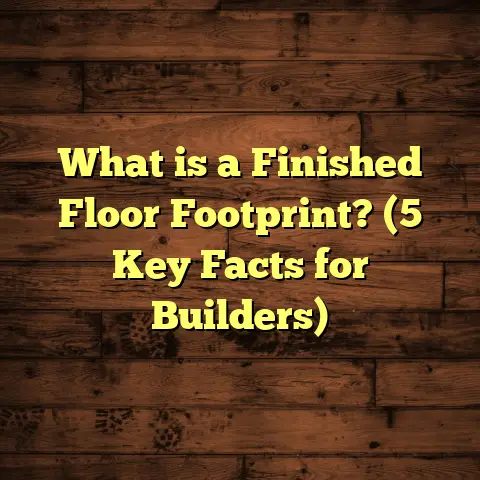What is a Mezzanine Floor? (5 Key Benefits for Space Maximization)
I still remember the first time I walked into a warehouse that had been transformed with a mezzanine floor. The vast space seemed to double in size, and I couldn’t help but feel a sense of awe at how effectively it had been utilized. It was a simple yet brilliant idea that turned an otherwise underused area into a vibrant hub of activity.
Now, why would someone consider adding a mezzanine floor to their space? Having worked in various flooring and construction projects, I can tell you that these structures come with some significant perks. Let’s dive into some key benefits of mezzanine floors and explore how they can maximize your space.
Making the Most of Vertical Space
In many commercial properties, especially warehouses, the challenge often lies in maximizing vertical space. Typically, these buildings have high ceilings that are underutilized. A mezzanine floor can be an ideal solution, adding an additional level without needing to expand the building’s footprint.
For instance, in a standard warehouse with an 18-foot ceiling, installing a mezzanine at around 10 feet can create a whole new level for storage or office space. This not only increases usable square footage but also helps organize the area better. I once worked on a project where we added a 1,500 square foot mezzanine, which effectively doubled the usable space without incurring the costs of moving to a larger property.
Cost-Effective Expansion
You might be wondering about the costs involved in such a project. Generally speaking, constructing a mezzanine floor can be much more affordable than relocating or building an entirely new structure. On average, you can expect to spend between $20 to $50 per square foot for the installation of a mezzanine, depending on materials and design choices.
In contrast, moving to a new location can involve rental increases, moving costs, and downtime that can affect your business operations. One case study I encountered was a local retail store that faced rising rental costs. By adding a mezzanine for an additional 800 square feet of storage, they saved thousands in potential relocation expenses while keeping their operation running smoothly.
Flexibility in Design
One of the best parts about mezzanine floors is their flexibility in design. Whether you’re looking for a simple platform for storage or an elaborate office space with glass walls and lighting fixtures, there is room for creativity.
I remember working with a client who wanted a multi-functional space. We designed a mezzanine that included both storage and a cozy lounge area for employees to take breaks. The result was not only practical but also visually appealing. With custom railings and finishes tailored to fit their brand’s aesthetic, the mezzanine became a conversation starter for visitors.
Enhanced Productivity
When spaces are organized efficiently, productivity often improves. A well-planned mezzanine allows for better organization of supplies and equipment, which means less time spent searching for items and more time dedicated to work.
In one project I observed, a manufacturing company installed a mezzanine mainly for inventory storage. The result was remarkable: they reported a 25% increase in productivity due to reduced time spent on inventory management. Employees could grab what they needed quickly and get back to their tasks without unnecessary delays.
Easy Accessibility and Safety
Safety is always a priority in any workspace. Mezzanines are designed with safety features such as guardrails and non-slip surfaces which not only comply with regulations but also provide peace of mind.
I’ve seen many mezzanines equipped with staircases or lifts that ensure easy access from the ground floor. This thoughtful design element is crucial, especially in busy environments where employees frequently move between levels. Additionally, using durable materials like steel can support heavy loads while maintaining safety standards.
Maximizing Storage Solutions
Let’s talk about storage—an area where mezzanines truly shine. With the right design, you can convert that empty vertical space into valuable storage options. Many businesses find themselves struggling with clutter and disorganization. A mezzanine can help alleviate this pressure by providing additional shelving or racking systems above existing operations.
For example, I worked on a project for an e-commerce business that was rapidly growing. They were running out of floor space for their inventory but had high ceilings that were underutilized. By installing a mezzanine equipped with various shelving units, they managed to increase their storage capacity by over 40%. This transformation allowed them to maintain inventory levels without the need for new warehouse space.
Streamlining Operations
Another advantage of mezzanine floors is their ability to streamline operations within your facility. When designed thoughtfully, they can create distinct zones for different functions—like separating production areas from storage spaces or administrative offices.
During one project at a manufacturing plant, we created separate zones by adding a mezzanine specifically for office functions above the production line. This not only provided managers with direct oversight of operations but also allowed employees to work in quieter conditions away from the noise of machinery.
Customization Options
The versatility of mezzanines extends beyond just functionality; they can also be customized to fit your unique business needs. From varying heights and load capacities to specific layouts and finishes, there’s no one-size-fits-all solution.
For instance, I once collaborated with an art studio that wanted to integrate a creative workspace within their existing layout. We designed a mezzanine that featured open spaces filled with natural light while also providing soundproofing materials to minimize noise distractions from the ground floor workshops. This customization resulted in an inspiring environment that fostered creativity.
Energy Efficiency
Incorporating energy-efficient designs into your mezzanine can further enhance its value. Consider integrating features like skylights or energy-efficient lighting systems that reduce energy consumption while creating an inviting atmosphere.
In one particular installation for an office space, we used LED lighting combined with large windows that let in natural light during the day. This not only cut down on electricity costs but also created an uplifting work environment—employees felt more energized and focused in spaces filled with natural light.
Case Study: Retail Transformation
Let’s take a closer look at a retail transformation involving a mezzanine installation. A clothing store located in a bustling urban area faced limitations due to its compact size. The owners wanted to expand their sales floor without leaving their prime location.
After assessing the layout, we proposed adding a 1,200-square-foot mezzanine that would serve as both additional retail space and employee storage. The implementation took approximately three months, during which time we ensured minimal disruption to their operations.
The outcome was remarkable: the store saw an increase in foot traffic and sales by 30% within six months of opening the newly designed space. Customers loved the fresh layout and expanded offerings while staff appreciated having designated areas for stock management.
Challenges and Considerations
While there are numerous benefits associated with mezzanine floors, it’s essential to consider potential challenges as well. One common issue relates to building codes and regulations—each municipality has specific guidelines regarding height restrictions and structural integrity requirements.
I’ve encountered cases where clients faced hurdles due to local zoning laws limiting the maximum height of structures within commercial properties. It’s crucial to conduct thorough research before proceeding with any construction plans to avoid unexpected setbacks or costs down the line.
Additionally, ensuring proper load-bearing measures are in place is vital for safety reasons. Consulting with structural engineers during the planning phase will help determine weight capacities based on the intended use of your mezzanine.
The Future of Mezzanine Floors
As businesses continue evolving alongside technological advancements, it’s likely we’ll see even more innovative uses for mezzanine floors in the future. From incorporating smart technology features like automated shelving systems to creating collaborative workspaces that promote creativity—there’s no limit to what can be achieved.
I’m excited about how these developments will shape our approach toward maximizing space efficiency across various industries while maintaining safety standards and enhancing employee satisfaction.
Conclusion
In my experience as a flooring contractor, I’ve come to appreciate the numerous benefits that mezzanine floors offer for space maximization. They provide cost-effective solutions for expanding usable areas without the need for costly relocations or extensive renovations.
By making strategic design choices and understanding your space’s specific needs, you can turn your vertical space into an efficient, productive part of your operation. So if you’re considering options to utilize your space better, think about what a mezzanine can do for you!





